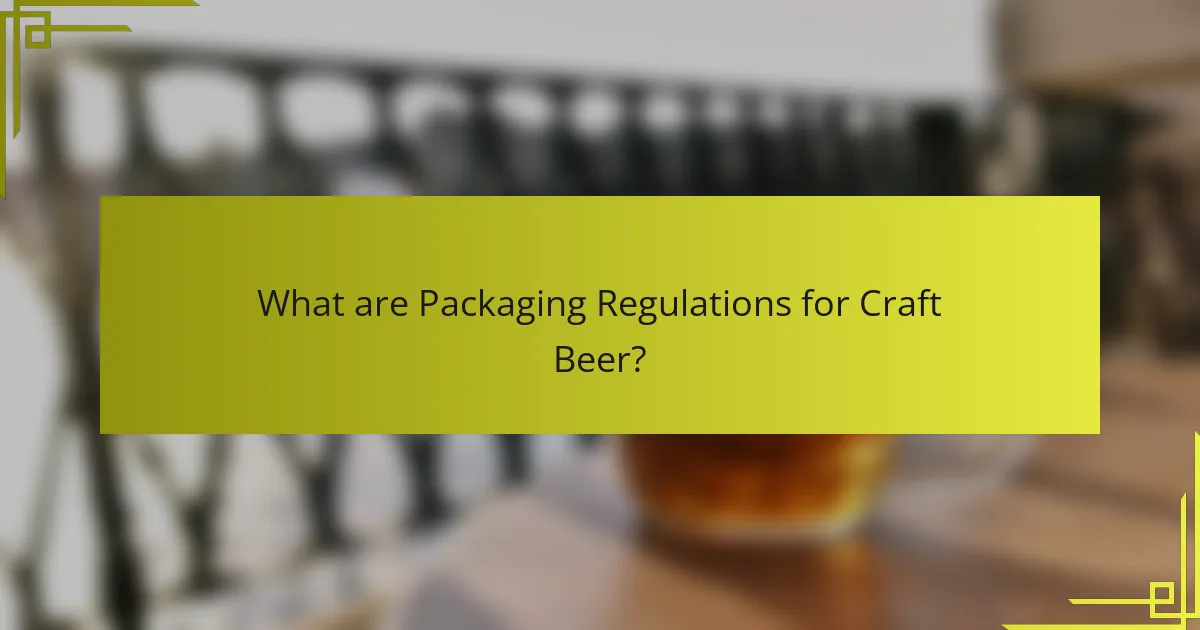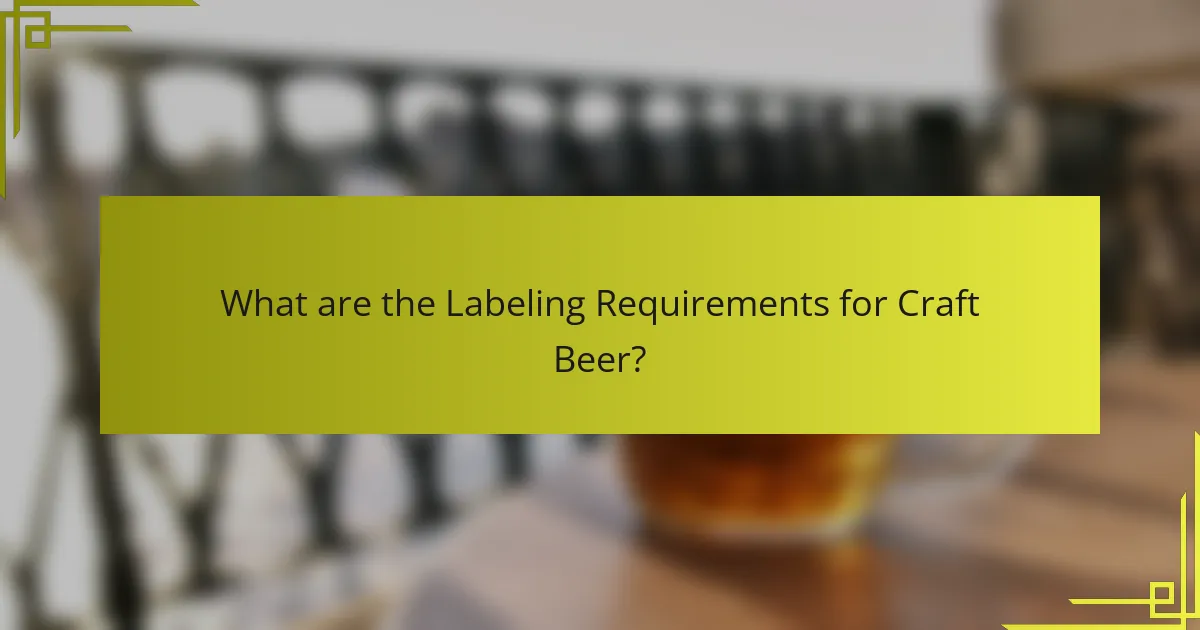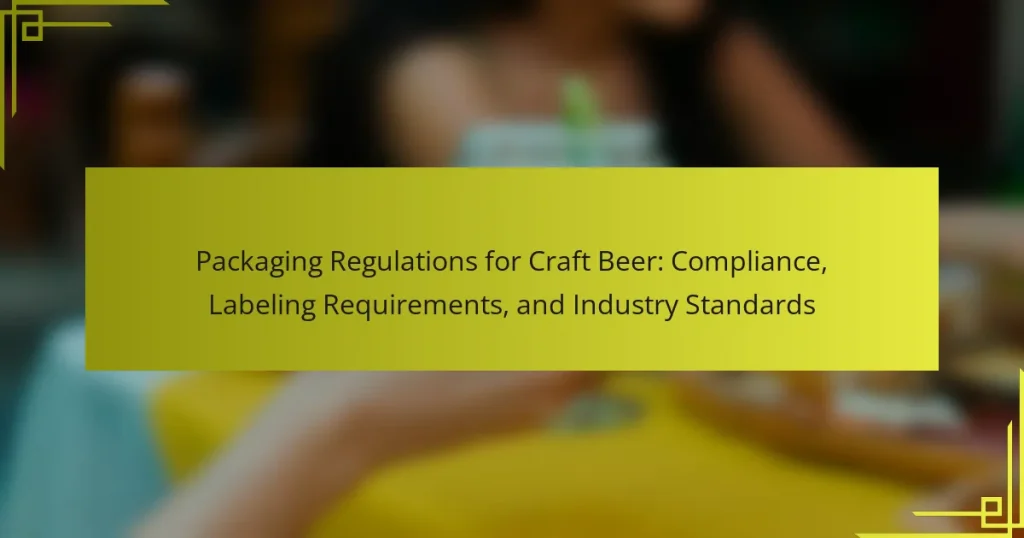Packaging regulations for craft beer encompass a range of compliance standards that breweries must follow to ensure legal operation and consumer safety. These regulations focus on essential aspects such as labeling, safety, and environmental considerations, requiring specific information like the brewery name, beer type, and alcohol content on labels. Additionally, packaging materials must be safe for food contact and include recycling information, while compliance with federal guidelines from the Alcohol and Tobacco Tax and Trade Bureau (TTB) is necessary for approval. Understanding these regulations is crucial for craft breweries to avoid fines and ensure accurate representation of their products to consumers.

What are Packaging Regulations for Craft Beer?
Packaging regulations for craft beer involve specific compliance standards that breweries must adhere to. These regulations primarily focus on labeling, safety, and environmental considerations. Labels must include the name of the brewery, the type of beer, and the alcohol content. Additionally, health warnings are mandatory in many jurisdictions.
Packaging materials must be safe for food contact and often require recycling information. Many states have unique regulations regarding the size and shape of containers. For instance, some states restrict the sale of beer in certain container sizes. Compliance with the Alcohol and Tobacco Tax and Trade Bureau (TTB) guidelines is also crucial for federal approval.
Breweries must ensure that their packaging does not mislead consumers. Accurate representation of ingredients and brewing methods is essential. Non-compliance can lead to fines or product recalls. Thus, understanding and following packaging regulations is vital for craft breweries to operate legally and successfully.
How do packaging regulations impact craft beer production?
Packaging regulations significantly impact craft beer production by dictating compliance standards that brewers must follow. These regulations ensure that packaging materials are safe and suitable for food and beverage use. They also require specific labeling information, such as alcohol content and ingredient lists. Failure to comply can result in fines or product recalls. Additionally, regulations can influence packaging design choices, affecting branding and marketability. The Alcohol and Tobacco Tax and Trade Bureau (TTB) enforces these regulations in the United States. Craft breweries must navigate these complexities to maintain legal operation and consumer trust.
What are the key components of packaging regulations?
Key components of packaging regulations include labeling requirements, material safety, and environmental compliance. Labeling requirements mandate clear information about the product, including ingredients, alcohol content, and health warnings. Material safety ensures that packaging materials do not pose health risks to consumers. Environmental compliance involves regulations regarding recyclability and waste management of packaging. These components are critical for ensuring consumer safety and maintaining industry standards. Compliance with these regulations helps prevent legal issues and promotes responsible marketing practices.
How do regulations vary by region or country?
Regulations for craft beer packaging vary significantly by region and country. In the United States, the Alcohol and Tobacco Tax and Trade Bureau (TTB) oversees labeling and advertising. They require specific information such as the alcohol content and health warnings. In the European Union, regulations focus on consumer protection and require ingredient listings and allergen information. Countries like Canada have their own requirements, which include bilingual labeling. Additionally, some regions impose regulations on container sizes and recycling. These variations reflect local laws and cultural attitudes towards alcohol consumption.
Why is compliance important for craft breweries?
Compliance is important for craft breweries to ensure legal operation and maintain market access. Adhering to regulations helps breweries avoid fines and legal issues. Compliance also builds consumer trust and brand reputation. For example, breweries must follow labeling requirements to accurately inform consumers about ingredients and alcohol content. Non-compliance can lead to product recalls or bans from retail outlets. Additionally, regulatory compliance supports fair competition within the industry. It ensures that all breweries meet the same safety and quality standards. This contributes to overall public health and safety in the beverage industry.
What are the potential consequences of non-compliance?
Non-compliance with packaging regulations for craft beer can lead to significant penalties. These penalties may include fines imposed by regulatory agencies. Businesses may also face product recalls, which can result in financial losses. Non-compliance can damage a brand’s reputation, leading to decreased consumer trust. Additionally, companies may encounter legal action from competitors or consumers. In severe cases, non-compliance can result in the suspension of business licenses. Ultimately, these consequences emphasize the importance of adhering to industry standards and regulations.
How can breweries ensure they remain compliant?
Breweries can ensure compliance by adhering to federal, state, and local regulations. They must obtain necessary licenses and permits to operate legally. Breweries should follow the Alcohol and Tobacco Tax and Trade Bureau (TTB) guidelines for labeling and advertising. Accurate record-keeping of production and sales is essential for compliance. Regular training for staff on compliance issues can help maintain standards. Breweries should stay updated on changes in regulations to avoid violations. Engaging with industry associations can provide resources and support for compliance efforts. Regular audits can also identify areas needing improvement in compliance practices.

What are the Labeling Requirements for Craft Beer?
Craft beer labeling requirements include specific information mandated by the Alcohol and Tobacco Tax and Trade Bureau (TTB). Labels must feature the name of the brewery, the brand name of the beer, and the type of beer. The alcohol content must be clearly stated in terms of Alcohol by Volume (ABV). Additionally, the net contents must be indicated in fluid ounces.
Labels must also include a government warning about alcohol consumption. Ingredients are not required on the label, but many breweries choose to include them voluntarily. The label must not be misleading and must comply with all applicable federal and state laws. Compliance with these requirements ensures that craft beer is accurately represented to consumers.
What information must be included on craft beer labels?
Craft beer labels must include the name of the beer, the name and address of the brewery, and the alcohol by volume (ABV) percentage. Additionally, labels should specify the beer style and provide a net contents statement, indicating the volume of the product. Ingredients may also be listed, although this is not mandatory in all regions.
The Alcohol and Tobacco Tax and Trade Bureau (TTB) regulates these labeling requirements in the United States. Compliance with these regulations ensures that consumers receive accurate information about the product. Failure to adhere to these guidelines can result in penalties or product recalls.
How do labeling requirements differ for various types of beer?
Labeling requirements for various types of beer differ based on regulatory classifications. For example, craft beer often requires specific information about the brewer and ingredients. The Alcohol and Tobacco Tax and Trade Bureau (TTB) mandates that labels must include the name of the beer, the type of beer, and the alcohol content. Additionally, beers categorized as specialty or flavored must disclose the added flavoring ingredients.
Furthermore, beers sold in different states may have unique state-level labeling requirements. Some states require additional health warnings or nutritional information. Compliance with these varying regulations is crucial for market access. Accurate labeling helps consumers make informed choices and ensures adherence to legal standards.
What are the common labeling mistakes to avoid?
Common labeling mistakes to avoid include inaccurate information, missing mandatory details, and unclear fonts. Inaccurate information can mislead consumers about the product’s contents or alcohol content. Missing mandatory details, such as the brewer’s name or the alcohol by volume (ABV), can result in regulatory penalties. Unclear fonts make it difficult for consumers to read essential information. Additionally, failing to use appropriate language can lead to misinterpretation of the product’s nature. Not adhering to state-specific regulations can also cause compliance issues. Lastly, using outdated or non-compliant labels can result in recalls or fines. These mistakes can undermine consumer trust and lead to legal challenges.
Why is accurate labeling crucial for consumer trust?
Accurate labeling is crucial for consumer trust because it ensures transparency and informs purchasing decisions. Consumers rely on labels to understand product ingredients and nutritional information. Misleading labels can lead to consumer mistrust and potential health risks. Research shows that 70% of consumers check labels before buying food and beverages. Accurate labeling fosters brand loyalty and repeat purchases. In the craft beer industry, compliance with labeling regulations enhances credibility. Trustworthy brands are more likely to succeed in a competitive market.
How does labeling affect consumer purchasing decisions?
Labeling significantly influences consumer purchasing decisions by providing essential information about products. Clear and informative labels can enhance product appeal and foster trust. Consumers often rely on labels to understand ingredients, nutritional value, and origin. Research indicates that 67% of consumers check labels before making a purchase. Labels also convey brand identity and compliance with regulations. Effective labeling can differentiate products in a crowded market. For craft beer, specific labeling requirements can enhance credibility. Thus, labeling plays a crucial role in shaping consumer choices and driving sales.
What role does labeling play in brand identity?
Labeling plays a crucial role in brand identity by providing essential information and creating a visual representation of the brand. It communicates the brand’s values, story, and product details to consumers. Effective labeling differentiates a brand from competitors in a crowded market. It can influence consumer perception and purchasing decisions. A well-designed label can enhance brand recognition and loyalty. According to a study by the Journal of Consumer Research, 64% of consumers are more likely to buy a product with distinctive packaging. This underscores the importance of labeling in establishing a strong brand identity.

What are the Industry Standards for Craft Beer Packaging?
Industry standards for craft beer packaging include compliance with federal and state regulations. Packaging must be designed to protect the product from contamination and spoilage. Common materials include glass bottles, cans, and kegs. Labels must provide essential information, such as alcohol content and ingredients. Additionally, packaging should comply with the Alcohol and Tobacco Tax and Trade Bureau (TTB) requirements. These standards ensure consumer safety and accurate product representation. Craft breweries often follow guidelines set by the Brewers Association for sustainable practices.
What organizations set industry standards for craft beer packaging?
The organizations that set industry standards for craft beer packaging include the Brewers Association and the Alcohol and Tobacco Tax and Trade Bureau (TTB). The Brewers Association provides guidelines focused on quality and sustainability in packaging. The TTB regulates labeling and advertising to ensure compliance with federal laws. These organizations help maintain consistency and safety in craft beer packaging. Their standards are crucial for consumer protection and industry integrity.
How do these standards influence packaging design?
Standards influence packaging design by dictating compliance with labeling and safety regulations. These standards ensure that packaging provides essential information, such as alcohol content and ingredients. They also mandate the use of specific symbols or warnings on labels. Adhering to these requirements enhances consumer safety and product transparency. Additionally, standards can dictate materials used in packaging to ensure environmental sustainability. For example, regulations may encourage the use of recyclable materials. Compliance with these standards not only meets legal obligations but also promotes brand trust and consumer confidence.
What are the sustainability considerations in industry standards?
Sustainability considerations in industry standards focus on reducing environmental impact. These standards often emphasize resource efficiency, waste reduction, and energy conservation. They may include guidelines for using recyclable materials in packaging. Additionally, they promote sustainable sourcing of ingredients. Many standards encourage the use of renewable energy in production processes. Compliance with these standards can enhance brand reputation. Research indicates that consumers prefer products with sustainable packaging. This trend drives companies to adopt greener practices for competitive advantage.
How can breweries stay updated on industry standards?
Breweries can stay updated on industry standards by regularly consulting industry associations. Organizations like the Brewers Association provide resources and guidelines. They also offer training sessions and workshops on compliance. Attending industry conferences helps breweries network and learn about new regulations. Subscribing to industry publications keeps breweries informed about changes. Engaging with local regulatory bodies ensures adherence to local laws. Utilizing online resources, such as government websites, offers real-time updates on compliance standards. Following relevant social media channels can also provide timely information on industry trends.
What resources are available for breweries to learn about packaging standards?
Breweries can access various resources to learn about packaging standards. The Brewers Association provides guidelines and educational materials on packaging compliance. The Alcohol and Tobacco Tax and Trade Bureau (TTB) offers federal regulations and requirements for labeling and packaging. Industry publications, such as Brewbound and Craft Beer & Brewing, frequently cover packaging standards and best practices. Additionally, trade shows and conferences often feature sessions on packaging innovations and regulations. Online courses and webinars from organizations like the American Society of Brewing Chemists can enhance understanding of packaging processes.
How can breweries participate in shaping industry standards?
Breweries can participate in shaping industry standards by engaging in industry associations and advocacy groups. These organizations often develop guidelines and best practices for packaging and labeling. Breweries can also contribute to public consultations and discussions with regulatory bodies. This involvement ensures their perspectives are considered in the formulation of standards. Furthermore, breweries can collaborate on research initiatives to address emerging issues in packaging. By sharing their experiences, they can influence the development of effective regulations. Participation in workshops and seminars can also enhance their understanding of compliance requirements. Ultimately, active involvement fosters a collaborative environment for industry improvement.
What are best practices for compliant craft beer packaging?
Best practices for compliant craft beer packaging include adhering to federal and state labeling regulations. Labeling must include the name of the brewery, the type of beer, and the alcohol by volume (ABV) percentage. The packaging should also contain a government warning statement regarding alcohol consumption. Additionally, ingredients must be listed if required by state law. Packaging must not promote excessive consumption or appeal to minors. Using approved materials for containers is essential to ensure safety and compliance. Regularly reviewing and updating packaging practices according to regulatory changes is critical for ongoing compliance.
How can breweries implement effective labeling strategies?
Breweries can implement effective labeling strategies by ensuring compliance with regulatory standards. They should clearly display essential information such as alcohol content, ingredients, and health warnings. Using attractive designs can enhance brand recognition and appeal to consumers. Breweries must also consider the target market when designing labels. Research shows that visually appealing labels can increase consumer purchase intent by up to 30%. Additionally, breweries should regularly review labeling regulations to stay updated on any changes. Engaging with consumers through feedback on label designs can further refine their approach.
What steps can be taken to ensure sustainable packaging solutions?
Implementing sustainable packaging solutions involves several key steps. First, companies should assess their current packaging materials. This includes identifying recyclable and biodegradable options. Next, businesses can prioritize using materials sourced from renewable resources. Utilizing minimal packaging can also reduce waste and environmental impact. Collaborating with suppliers who share sustainability goals is essential. Additionally, companies should educate consumers about proper disposal methods. Regularly evaluating packaging processes for improvements is crucial. Finally, adopting a circular economy approach can further enhance sustainability efforts.
Packaging regulations for craft beer are essential compliance standards that breweries must follow, focusing on labeling, safety, and environmental considerations. Key components include mandatory information such as the brewery name, beer type, and alcohol content, alongside health warnings. The article also explores how these regulations impact production, the importance of compliance for maintaining market access, and the potential consequences of non-compliance. Additionally, it covers regional variations in regulations, industry standards, and best practices for sustainable and compliant packaging solutions.




